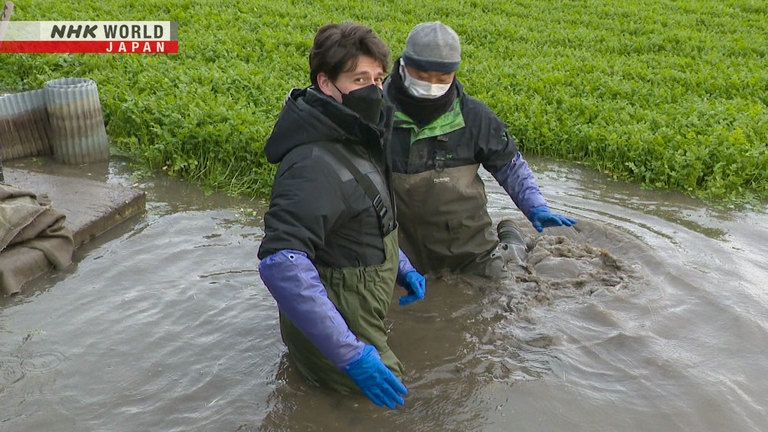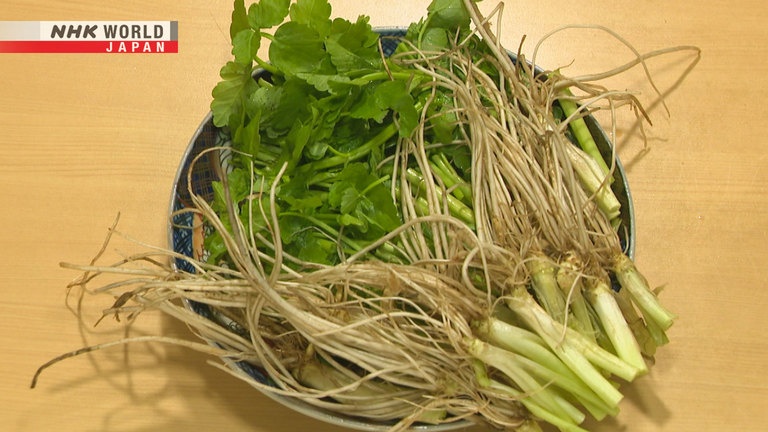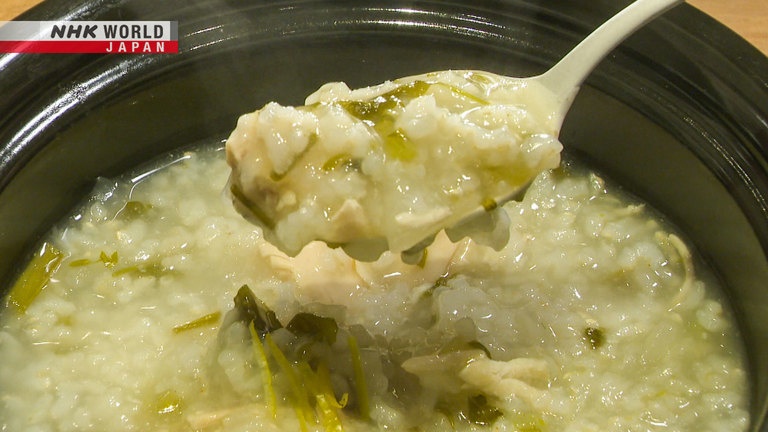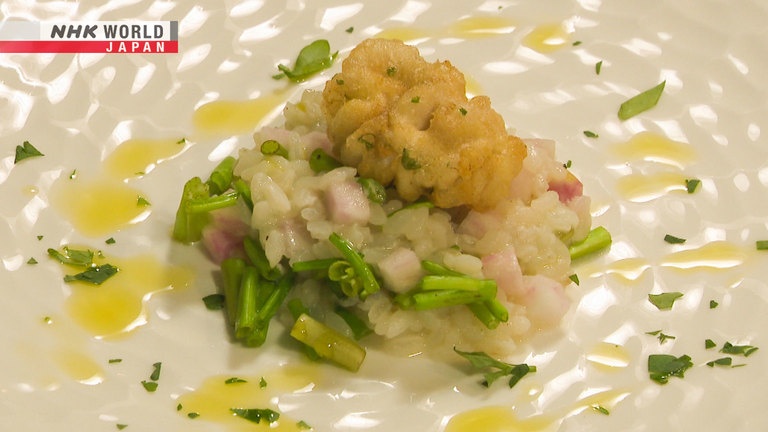SERI
Seri, in season from winter to spring, was a key source of nutrition during harsh winters when produce was scarce. It grows in cold, mineral-rich water, giving it a delectable crunch and aroma. Join our reporter in muddy, flooded paddies for a harvest experience and check out a local dish that took on an iconic role in post-earthquake recovery. Also visit TOKYO SKYTREE for seri Italian dishes that are truly inspired. (Reporter: Kyle Card)




Transcript
Tokyo: this world-class metropolis is a veritable gourmet wonderland.
Discover the stories behind the ingredients that make this city so delicious - so oishii.
Our focus today is seri -water celery- a vegetable eaten in winter and early spring.
Seri offered nutrition during cold winter months, when most other veggies were out of season in Japan.
Crisp!
That's right.
A crisp texture and savory aroma are what make it great.
This is a seri field.
Not a pond? Wow.
Seri need a lot of water to grow - it's what gives the vegetable that delectable crunch.
It's perfect for soba or saucy side dishes.
And used in a number of winter recipes including zoni, a New Year's dish.
Seri's been a key part of Japanese winter for centuries.
Dig in to see what the fuss is all about.
Trails to Oishii Tokyo.
Hi, there.
My name is Kyle Card, and today's theme is seri.
Truth be told, I know little to nothing about this vegetable, so I'm very excited to finally try it and learn all about it.
So, why don't we go discover seri together?
To learn more about seri's cultural importance, Kyle heads to a porridge restaurant.
So it looks like the place.
For one month out of the year, they serve a "seven herb porridge" that contains seri.
It has seven spring herbs, rice, and chicken, all in a chicken-based broth.
Thanks for waiting.
Seven herb rice porridge.
- May I open it?
- Of course.
It looks beautiful.
It's a traditional dish eaten on January 7th,
after New Year's, to wish for good health and fortune.
The seven herbs used, including seri, are all early-winter crops.
Since they grew in cold weather, it was believed that eating them promoted safety and health into the New Year.
Alright. Let's try this.
Gentle flavor.
Tasty.
Thank you.
The porridge was also eaten as a way to settle the tummy after a long holiday of drinking and overeating with family.
The custom is said to be over 500 years old.
Seri's been warming hearts and souls in Japan for generations.
Kyle's next stop is a greengrocer in Tokyo.
The shop gets produce from selected growers across the country, and only offers vegetables that are currently in season.
The seri are here.
Oh, there?
Yes.
They have a crisp texture when fresh.
What makes them so crisp?
Because they're fresh.
They're in bags with holes cut in them,
and placed in a bucket of water.
That allows them to take in water
so they stay crisp and don't dry out.
I see.
The roots stay intact to absorb water, and maintain freshness.
The roots are the best during the winter.
- You eat the roots?
- Yes. They're good, you just have to clean them.
The roots have actually been a favorite from the beginning.
A food encyclopedia from around 300 years ago describes the roots as a prized ingredient, comparing them to thin, white somen noodles.
The homegrown vegetable has been a source of pride for quite a while.
Is seri nutritious?
It's rich in vitamin C and minerals.
It's available during winter,
when the common cold goes around.
Seri's believed to boost the immune system,
protecting the body.
Nature's blessing.
Fantastic.
Seri was a valuable source of nutrition during long and harsh winters.
The shop's supplier is in Natori, Miyagi.
With no time to waste, Kyle prepares to leave town.
He hitches a ride on a bullet train, and then a local train, on a trip that takes about two hours in total.
Miyagi boasts the largest annual shipment of seri.
Natori is the prefecture's center, accounting for 80% of production.
Kyle arrives in Shimoyoden, a key seri district.
Hello.
I'm Kyle.
I'm Miura.
I've heard good things about your seri.
Oh, thank you.
Miura will cook up some of his seri for Kyle.
Just boil them.
Until they get a bit softer.
While keeping a nice crisp texture?
Yeah, don't over boil. Keep them crisp.
Great color.
They're done.
Already? That was quick.
Now we cut them up.
Seri is mixed in with fried tofu and stringy konnyaku.
He adds a bit of mentsuyu, a soy sauce-based sauce.
It's basically a side dish.
It can be eaten with rice.
It's cooked and seasoned lightly.
The local favorite, seri-yaki, is served.
Beautiful green color.
Nice sound.
Crisp!
It is so crisp and fresh.
And it's got this like...
it's got this delicate aroma and flavor to it but it doesn't have that kind of overpowering...
like a grassy flavor or aroma to it either.
It's just very easy to eat.
Very nice. A unique flavor to it.
Yeah, you could just keep munching it.
It doesn't have any strange flavor to it.
Even with things like spinach and things like that, there's a bit of a spinachy bitterness to it.
This doesn't have any sort of bitterness per say.
Now for the next dish.
Seri and wood ear mushrooms are fried in sesame oil.
All about texture and aroma.
Goes great with alcohol.
With booze. I see.
You don't cook them for long.
Yeah, not really.
They're a source of vitamins in snow country,
so it's best not to overcook them.
And they taste better if you
eat them while they're still fresh.
Get all the nutrition you can during winter.
Exactly.
Ready in a flash.
Time to eat.
Should be both crisp and crunchy.
Sounds great. Can't wait.
Alright, here we go.
Again, great texture.
That's seri for you.
Definitely crisp and crunchy.
The crunchiness is from the wood ear mushrooms.
But fun textures aren't all the dish has to offer.
Frying in oil gives it a softer flavor.
Right. Oil covers it.
I could eat this forever.
Green veggies with no earthy pungency.
Excellent.
Is that part edible?
The roots are best this time of year.
They take time to clean, though.
It needs to be done carefully with a toothbrush.
A toothbrush? What a pain.
Seri - good all the way down to the roots.
So, how's it grown?
Kyle returns the next day to learn more.
Good morning.
Show me how to grow tasty seri.
Okay, but not in those clothes.
You'll need to wear something like this.
Where on earth do they grow?!
Kyle heads to the changing room.
I got a bad feeling about this.
What have you gotten me into?
Let's get to it.
This is the field.
Not a pond?
Well, sort of.
Seri are grown in flooded paddies.
They naturally occur in wetlands, so they need lots of water.
This is where we harvest.
Here?
Wow.
It looks so cold!
Soft mud!
It's so soft.
It's like walking on...
oh, wait... and I'm stuck.
What's the best way to walk through this?
Twist your body and move your knee
forward as you pull your foot up.
Got it.
Keep twisting.
Now kneel down.
I did it!
Oh, I was worried there for a moment.
Time to pull up some seri.
Using this part of the hand,
tug at the roots and scrape off dirt.
Do one at a time.
Be careful not to break the roots.
Wash off the mud, and repeat.
Give it a try.
Dig down and pull. How deep should I go?
5 to 10 centimeters should do.
They're fragile, so be careful.
- Like this?
- Good.
Remove the mud.
We got seri!
This is tough work.
They're so fragile that harvesting has to be done by hand - no help from machines.
During peak season, he works full days by himself, from 8 am to sundown.
Miura lost his father early in life.
He took over the farm when he turned 20, after training under his grandfather.
He's now in his forties.
Our community has been
growing seri for 400 years.
That's a long time.
Right.
Does the region have an ideal climate?
We get a lot of good water.
Water from the Natori River runs underground.
It comes up when you dig a hole.
The water temperature was perfect,
so it was a good spot for growing seri.
The mineral-rich groundwater stays at around 15 degrees Celsius all year round.
Seri wouldn't grow well in lower temperatures.
Any higher and the stalks would grow too long and thin.
15 degrees makes for thick stalks, and a crisp texture.
Such fine, beautiful mud.
Like cake batter.
How do you get it this way?
We have sludge worms move through it.
Miura's organic farming involves a large number of sludge worms.
They burrow into the mud, feed on organic matter and microorganisms, and excrete waste onto the surface.
The process makes a natural compost that's rich in nutrients.
Coldness is important for flavor.
Cold?
They taste better if they're cold.
Seri store nutrients to withstand the cold, making them tastier all the way down to the roots.
Cold is the best condiment.
Cold is the best condiment... well said.
Winter is when people want seri.
It's important to maintain that culture.
How do people do that here?
Eating seri hot pots during cold months
has become a tradition in the area.
Hot pots?
Kyle visits Sendai in central Miyagi to track down a seri hot pot restaurant.
He finds an izakaya that's built up quite a reputation.
- Excuse me.
- Welcome.
I've come for a seri hot pot.
Thank you.
Thanks for having us.
Sure.
Seri hot pot is a great way to savor the vegetable.
Of course, the roots are served as well.
But they have to be washed carefully to get rid of that pesky mud.
Here you are.
That's a lot.
Wow, look at all that seri.
And apparently, we're going to be eating the roots as well. Interesting.
I haven't eaten the roots yet, so this is exciting.
What a lovely pot.
Inside is a soy sauce-based broth of kombu kelp, katsuobushi, and a little duck meat.
- I'll tell you how to eat it.
- Okay.
Eat the roots after they cook
for about 10 to 15 seconds.
That's quick.
But the leaves and stems only need a few seconds!
That's because they're fresh and juicy.
This is just for eating seri.
We only serve seri here.
This is a first for me.
Kyle starts with the roots.
1, 2, 3, 4, 5, 6, 7, 8, 9, 10. 11, and 12.
Ready?
It's like burdock root.
Nice and crunchy.
Oishii.
Now for the leaves and stems.
Very flavorful with the dashi.
A bit sweet too. Interesting.
Is this your original recipe?
Not me, but the previous owner.
I stayed true to the basics, but changed
the soy sauce and mirin several times.
It eventually evolved into what it is now.
In a process of trial and error, he put in work to bring out the best in a local specialty.
Seri hot pot's fame is a recent phenomenon.
After Miyagi was affected by the Great East Japan Earthquake of 2011, the local government, restaurants, and farmers promoted the dish to bring in support for the area.
People come from other prefectures
to eat it this time of year.
It's becoming a regional specialty.
- Something unique to Sendai.
- Pretty much, yeah.
- That's exciting.
- It is.
Back in Tokyo, Kyle heads to an Italian restaurant that always has seri on its winter menu.
- Hello.
- Welcome.
- Thanks for having us.
- Thanks for coming.
What do you find special about seri?
It's a Japanese ingredient, but part of the same
family as watercress, used in Western cuisine.
I think it can fuse various Japanese
and Western recipes together.
How exciting.
They source ingredients directly from farms across Japan.
It's an Italian menu that pays homage to homegrown food.
Thanks for waiting.
Seri and milt risotto.
Elegant.
Great colors.
How is seri used here?
Seri pairs well with shirako. I want guests to
enjoy a good mix of flavor and aroma.
- Itadakimasu.
- Enjoy.
Oishii.
The crisp seri and creaminess make
an interesting pairing.
The richness of the shirako just really extends the aroma of the seri across the palate.
And again, the crispness of the seri as well, it goes so good with the softness of the shirako and with the slight crunch of the rice as well. It's really good.
Next, snow crab, garlic and chili pepper are sauteed in olive oil.
Seri goes in.
Then, he adds tomato sauce.
He's making pasta!
Seri and snow crab arrabbiata.
- This looks great.
- The sauce is a bit spicy.
I fried the roots too.
You can enjoy the whole seri.
Frying them seems rare.
Frying the root offers a unique flavor.
Great colors.
Oishii.
That's all I can say.
The spiciness of the arrabbiata and of course the freshness of the seri, it's just wonderful. It goes together.
Of course, now I'm going to try this fried, Fried roots.
Alright, here we go.
Deeper flavor.
It comes out as you chew.
A slight earthy flavor.
Yes, that's true.
The roots absorb and carry the crab umami.
It's an elegant match. Oishii.
Little did I know that seri was such a versatile, nutritious, refreshing, and of course delicious vegetable.
Not to mention a wonderful way to add some variety, color and vitamins to your culinary creations in the colder winter months.
It's no wonder that it's been so popular in Japan for hundreds of years.
And judging from that history, I have no doubt it will remain so for generations to come.
In Tokyo, every ingredient has its own story.